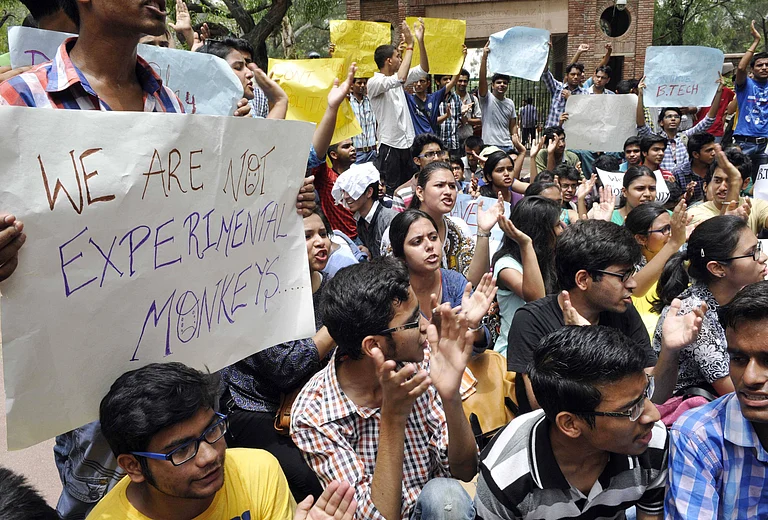Is this what liberalisation had in store for the city? "Economic reforms released an enormous demand, with the supply inadequately addressed by the Government," observes Michael Thompson, managing director, Colliers Jardine, Hong Kong headquartered real estate consultants, taking a look at the state of the Indian market. "A lot of non-resident investors felt the soaring prices in Bombay wouldn't sustain, and started looking at other cities," he adds. The metro attracted a lot of liberalisation-related publicity, but couldn't hold the interest it attracted. A real estate consultant calls it "the cocktail circuit evaluation process", and Niranjan Hiranandani, one of Bombay's most prominent builders, rubbishes the notion. "NRI investment has not been more than 5 per cent in Bombay, except in certain areas," he says optimistically. "The position is very simple. Prices shot up over 200 per cent, now they are tapering off."
The poor quality of houses available ill-matched with incredibly over-priced property; and a liquidity crunch, with corporates overstretched in the equities and real estate sectors, initiated the slump. "It was a balloon that had to burst," says N.C. Jain, chief commissioner of Income-Tax (IT). The IT Department's property auctions are one index of the state of the market. An auditorium packed with bidders, placards in hand, was a common sight a few months ago. Today, it's more a case of empty seats. In July 1995, the 12 flats and properties auctioned fetched rates well over the reserve price (purchase price plus 15 per cent), with a 1,820 sq yard plot of land in Andheri East (for commercial use) going for as much as Rs 1.42 crore over the reserve price, at Rs. 4.02 crore. In December 1995, in a changed market, out of 12 properties only four were sold, and three of them to public sector units. "The last two auctions have been bad. Compare them to the earlier ones and the change is apparent," says Jain.
Market analysts impute a host of other reasons as well for the downswing in Bombay:
- Wait-and-watch syndrome: This has been prompted by factors such as the development of commercial space in the suburban Bandra-Kurla area where an International Business and Finance Centre—inspired by Singapore—is coming up. Here, on land leased out (on 80-year leases) by the Bombay Metropolitan Region Development Authority, a 4-5 million sq ft area is being developed for commercial use. This will release a lot of commercial space, and prospective buyers are waiting for prices to even out to manage a better deal. Tata Housing sold a property to Lupin here, at Rs 20,000 a sq ft, in October 1994.In September 1995, another plot sold at Rs 18,000 a sq ft. Now, others are trying to sell at Rs 13,000 per sq ft.
- Mill area development: In the central Bombay Parel/Lalbaug areas, 10 million sq ft of mill land—surplus and sold out—is available for development into residential property. Its high quality buildings promise to change the skyline, and impact the prices in plusher areas such as Peddar Road, Worli, and Altamount Road, where some buildings are older and in poor repair.
- The slum re-development scheme (SRD): The Shiv Sena-BJP alliance promised a million houses for slum dwellers. The previous government had an SRD scheme with cross-subsidies for builders, which did not work. Here, the transfer of development rights (TDR) allows property to be developed elsewhere in lieu of land surrendered to the government for slum housing.
- The front office-back office syndrome: With the use of cellular phones and wide area networked computer-systems picking up steam, a lot of corporate, and even government offices, are opting to move out of high-priced south Bombay and out of the city in some cases. There are many companies which have even moved out of the state of Maharashtra.
The real estate boom, which wooed many a business house into territory ruled by the traditional Bombay builder community, now has many a finger burnt. Videocon, Mahindra & Mahindra, Tatas, Godrej, Reliance, Essar, to name some, found a new Mecca in real estate. But spirits aren't completely dampened yet. "We are a long-term player, not just here to ride on an appreciation curve. As far as Reliance is concerned we looked at it as a long-term opportunity," says Arvind Pahwa, president of Reliance Homes, a Reliance Industries division. S.K. Shelgikar, director of Videocon Properties Ltd, calls it a temporary phase. He says that the real estate price graph moves up every five years and then slides down. It's just that this time it has taken a wider swing.
Some of it is a perception swing. Bombay has been hit both by the liberalisation bug and the decline. When the Government opened up the economy, Maharashtra took the lead and aggressively marketed itself as India's frontline industrialised state. Former chief minister Sharad Pawar donned a suit and toured the developed world seeking NRI and foreign investment. He articulated, offered, marketed and projected what the state had to offer. "Corporate Maharashtra" was available, statistics et al, for the foreign and non-resident investor. The result: a boom, at least in interest. The City & Industrial Development Corporation (CIDCO) took a lead from the chief minister and kickstarted an aggressive marketing spree abroad, in August 1993. "We sold like cinema tickets—in Bangkok, Dubai, Singapore," says A. Bhattacharya, CIDCO's chief economist. Some 925 flats were booked on the spot, in the NRIs-only Seawoods Estate, located just outside Bombay. Another 200 are in the market now, but attracting a poor response.
"We hope to do a similar kind of aggressive marketing for the remaining flats sometime in July," says Bhattacharya ascribing the flagging NRI interest to the surging dollar and depreciating rupee, and the lack of strong marketing in the second round for the flats, which are priced at $90 to $95 (Rs 3,150-Rs 3,325) per sq ft.
So is the boom going bust? "There are no quick 'n' easy solutions to the problems in the market," says Thompson. But, consoles Hiranandani: "This is a temporary slowdown. It will pick up after the elections. There is a tremendous hidden demand—a huge actual user market in waiting." For Bombay then, patience is what will probably pay.


























